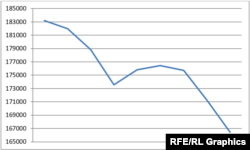Tehran’s stock exchange plunged on November 25 and 26 trading sessions in what could be the indirect result of U.S. sanctions, particularly on the country’s oil exports. It slightly recovered on Tuesday, but the outlook remains uncertain.
The United States reimposed sanctions on Iran’s crude oil exports on November 5, but oil sales had already taken a beating in the past few months. Iran’s oil exports of more than 2.5 million barrels per day have dropped to less than 1.5 million in the past three months.
Tehran Stock Exchange (TSE) main index plunged 2.8% or (4,789 points) day-to-day on November 26 to 166,463 points. The index in Nov.24 had also declined 2.54%.
Detailed numbers released on TSE’s official website indicate that the drop was mainly in shares of industrial companies, especially petrochemicals.
The industrial sector and particularly petrochemicals are the major players in Tehran’s stock market and market indicators show that the main index fluctuations have been exactly in line with the rise and decline of industry sector shares during 2018.
Industry and main indexes fluctuations during 2018:
As the Iranian currency began to lose its value from March, many investors flocked to the stock market to save their capital. Investors calculated that since petrochemical companies are mostly export-oriented, with 37% share in Iran’s total non-oil exports, their rial-based revenues would increase significantly after the devaluation of the national currency, pushing industry sector shares higher in the stock market.
The index has doubled in 2018, compared to last year, mostly because the national currency, rial, has dropped four-fold against US dollar during this period.
Some experts have also warned about a bubble in stock market. They argue that the rapid rise in the stock market is not normal, while GDP growth (at market prices, based on Iranian rials) is expected to decrease by 1.6% in 2018 and 3.6% in 2019.
The International Monetary Fund has also predicted that Iran’s GDP (at current US dollar rate) would reach $430 billion in 2018, but would plunge to $333 billion in 2019.
As so much of the stock market depends on petrochemicals and the economy on oil exports, the recent decline in the main index is due to plunging oil prices. World oil prices climbed to above $86/barrel in early October (highest levels since 2014) but declined to the current $60/barrel.
The prices of petrochemical products depend on crude oil and cheaper oil means lower income for those companies.
TSE’s main index from October 1 to November 26:
Source: TSE’s statistics
The details of statistics, released by TSE’s website indicate that Persian Gulf, Pars, Gol Gohar, Parsian, Tamin petrochemical companies, Bandar Abbas refinery as well as Mines And Metals Development Investment Company had the biggest role in the steep decline of the main index on November 26.








